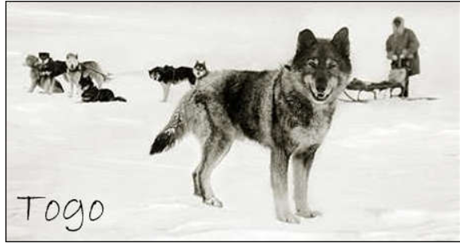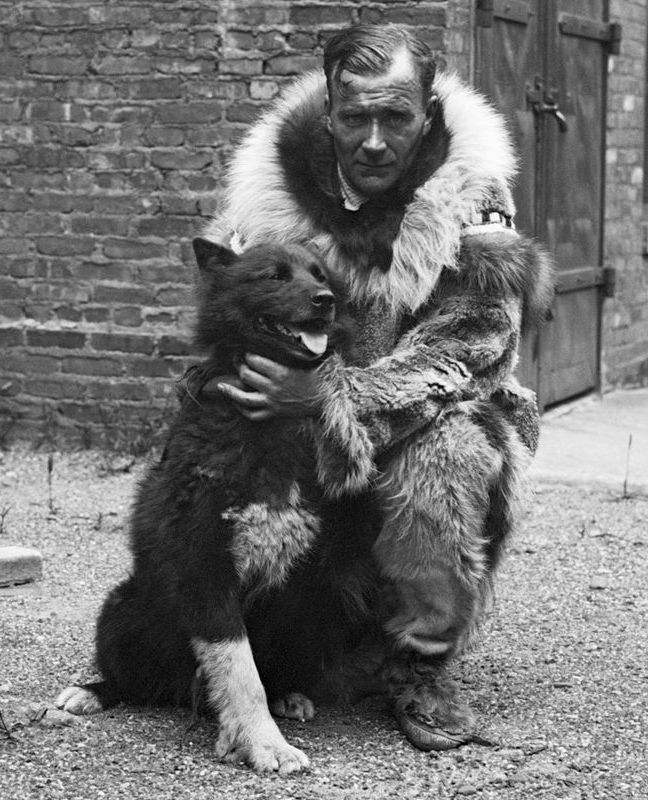When I say “Super Hero,” who or what comes to mind? Do you think of Superman, Iron Man, or Wonder Woman? Maybe you think of the Black Panther, Captain America, or Thor. Well, I know some real-life heroes and they aren’t humans – they’re animals! Animals with four paws and wagging tails who love to pull sleds. They’re Siberian Huskies – the great sled dogs of Alaska and other snowy countries. They are very brave and powerful. They can survive in freezing temperatures and blowing blizzards. They can run for hours pulling heavy sleds and battle fierce animals like grizzly bears and wolves. They are very smart, strong, and loyal.
And an amazing pack of Huskies saved a town in Alaska many years ago!
The year was 1925 and it was January in Nome, Alaska. People huddled inside their homes as the wind howled outside and Alaska froze. Families gathered around stoves and fireplaces to keep warm. They wrapped themselves in furs and watched as their cold breath swirled in the polar night air. Little did they know that a disease named Diphtheria was silently spreading across Alaska.

But one person did know and his name was Dr. Curtis Welch, the local doctor in Nome. He had treated a few children for colds, which later turned out to be Diphtheria, a dangerous and contagious disease. This was the worst time for a Diphtheria outbreak. Alaska was isolated and frozen. The shipping ports had closed two months prior, in November, and wouldn’t open until the following July. Plus, the doctor’s supply of antitoxin, or medicine, to treat Diphtheria had expired. What could he do?
He immediately contacted the mayor of Nome and started a quarantine in hopes of stopping the spread of the disease. But with everyone huddled together inside, the disease started to spread. The doctor sent urgent telegrams to Public Health in Washington, D.C., pleading for an emergency delivery of medicine. In these small Alaskan towns, the people had never been exposed to many diseases, including Diphtheria, so they had no natural immunity, or protection, against it. Everyone in the town could be lost.

An emergency meeting was held. A plan was discussed to deliver the medicine by plane. However, the conditions were too brutal for most planes to fly without freezing and the few planes that could make the flight had been dismantled, or taken apart, for the winter. They then thought about trains. It was a good plan, but with one hitch: the train could only go so far before the tracks were covered, frozen, and unusable. They then considered a dogsled team. It would be a round trip of over 600 miles and take 30 days in weather of -50 F or -46 C. Winds in Alaska were whipping at 25 mph and snowbanks were 10 ft or 3 m tall. The problem with this plan was that the medicine would only last for 6 days in this brutal weather.
So, the doctor and his team decided on a combined approach – train and multiple dog sled teams. By this time, 300,000 units of medicine had been found at a hospital in Anchorage, Alaska. The medicine was packed in quilts, wrapped in padding, and stuffed into a metal cannister weighting 20 pounds. The cannister was then put on a train for a short trip before being transferred to dog sled teams for the main trek, which started on January 27, 1925, at 9:00 p.m. The Great Race of Mercy was on!
The first dog sled driver, or musher, was “Wild Bill” Shannon, with his lead dog Blackie, and a team of 10 Huskies. The dogs yipped, barked, and jumped in excitement as they were hitched into their harnesses. They could sense the urgency in the air and were anxious to get started. The night was fiercely cold but their thick coats helped keep them warm. “Wild Bill” snapped the reins, yelled “mush” to the dogs, and they were off! The team raced over snowy trails and frozen rivers. On and on they raced through the frigid night, their breath appearing like steam from a racing locomotive. They arrived at the next stop at 3:00 the next morning, exhausted. “Wild Bill” was suffering from hypothermia (extreme cold) and his face was black from frostbite. The medicine was then placed by the fire to warm while “Wild Bill” and the dogs rested for four hours. They awoke and started the next leg of the trip, leaving 3 exhausted dogs behind.

“Wild Bill,” Blackie, and the team arrived in Minto at 11:00 a.m. the following morning and passed the medicine off to the next team led by musher Edgar Kalland. The team raced off through the forest in frigid temperatures, causing Edgar’s hands to freeze to the wooden handlebars of the sled. At a rest stop, a man had to pour boiling water on Edgar’s hands to release them from the sled.
And while this lifesaving race was underway, more cases of Diphtheria were spreading across Nome. More dog sled teams were added to the race to save precious hours. The medicine was passed from team to team as the heroic Huskies raced for hours across the frozen landscape. The weather was so extreme that several dogs on one team passed away from frostbite and their musher took over their spots, pulling the sled alongside the dogs.
Soon an artic storm was brewing. Gale force winds, dangerous white out conditions, and wind chill temperatures reaching -70 F, -57 C battered the dogs and mushers. But the brave Huskies of the Great Race of Mercy would not stop. For hours they barreled through unrelenting snow drifts and unforgiving terrain, their strong paws beating the snow in a race against time and Mother Nature. It was now January 30th. There were 27 cases of Diphtheria in Nome and rising. All the medicine was gone. Time was running out.
Meanwhile, a musher named Leonhard Seppala, his lead dog, Togo, and his team raced out from Nome into the storm to meet the incoming dog sled team. They raced for 91 miles in a gale-force blizzard with wind chills reaching -85F, -65C. Blinding snow pelted the dogs’ coats and slashed their eyes. They met the incoming team, transferred the medicine, then Seppala, Togo, and the team raced off into the night, only stopping to rest for a few hours, before starting again. Togo, Seppala, and the dogs then made the treacherous trip up and over Little McKinley Mountain, a total of 8 miles and 5,000 feet in elevation, in the raging storm. On the other side, exhausted and freezing, they transferred the medicine to the next team. It was now February 1st.
The next team took off into the storm and were blown off course, causing the musher to suffer severe frostbite while putting blankets on his dogs. The team arrived at the next transfer point at 7:00 p.m. that night. A new team of musher Gunnar Kaasen and his lead dogs, Balto and Fox, waited to see if the storm would stop. When it worsened, they decided to start the trek before the trail became lost completely. They raced into the storm at 10:00 p.m. They were battered by gales and blinding snow as they crossed Topkok Mountain. Gunnar couldn’t see the reins in front of him or the dogs through the swirling snow. At one point the sled overturned, burying the lifesaving medicine and canister. Gunnar dug furiously in the snow, panting with anxiety, his hands stiff with frostbite. But luck was with him – he found the canister, righted the sled, fastened the canister to the sled, and shouted to Balto, Fox, and his dogs to run.
On they raced, now ahead of schedule and nearing the end, arriving in Nome on February 2nd at 5:30 a.m. with the lifesaving antitoxin. The medicine had survived the trip and was thawed and ready for patients by noon the same day! The town was saved!
These strong, brave sled dogs raced over 600 miles on a lifesaving mission in subzero conditions and hurricane-force winds for a total of 127.5 hours, setting a world record. The dogs, along with their Alaskan and Norwegian mushers, were honored with gold medals, wreathes, and accolades.
A statute of Balto, the lead dog who crossed the finished line in Nome, was erected in New York’s Central Park in 1925. An inscription reads, “Dedicated to the indomitable spirit of the sled dogs that relayed antitoxin 600 miles over rough ice, across treacherous waters, through arctic blizzards, from Nenana to the relief of stricken Nome.” Three additional words were added at the bottom of the inscription: “Endurance · Fidelity · Intelligence.”
This race, while historic, also stirred some controversy. Most of the credit and fame from this race was bestowed upon lead dog Balto. However, many believe that lead dog Togo completed the longest, hardest part of the trek. He raced for 261 miles compared to Balto’s 55 miles. Some believe that Fox was the true lead dog on Gunnar’s team, not Balto. Also, the Alaskan mushers were not recognized as fully as the Norwegian mushers, even though they completed most of the race.
But I think all of us would agree that this was a historic and amazing mission of mercy that saved many lives. And you may wonder what happened to the dogs. Well, a few passed away from this demanding trek, but most survived. Balto lived until he was 14 and his body is now on display at the Cleveland Museum of Natural History. Togo lived to the age of 16 and is now on display at the Iditarod Museum in Wasilla, Alaska.
What do you think of this amazing race? Have you ever seen actual sled dog teams or watched the Iditarod races? Do you have a Siberian Husky as a pet? I think this is an amazing story of how man and animals can work together to accomplish great things. Siberian Huskies are an important – and lifesaving – part of life in various parts of the world.

